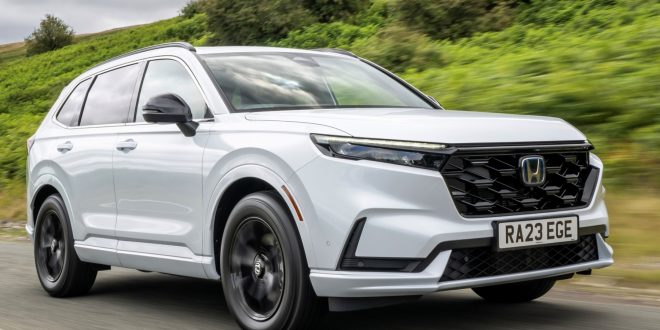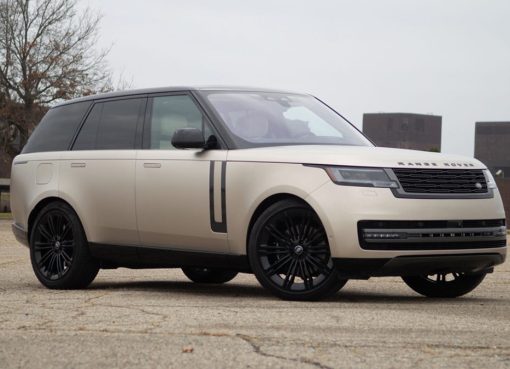Honda CR-V e:PHEV review – Automotive Blog

We road test the first plug-in hybrid from Honda – the all-new CR-V e:PHEV…
The Honda CR-V started off life as a pioneering family-friendly SUV way back in 1995. The Comfortable Runabout Vehicle’ is now in its sixth generation, and as a sign of the times, it’s now only available as a full hybrid (badged e:HEV) or plug-in hybrid (e:PHEV).
Such is the popularity of crossovers, the list of rivals for the CR-V is enormous these days, and includes the Toyota RAV4, Kia Sportage, Ford Kuga, Nissan Qashqai and Hyundai Tucson.
Wider, longer and taller than the previous generation car, we reckon the latest Honda CR-V is the best proportioned model yet with its chiselled lines and sporty stance.
It feels roomy and light as soon as you step into the cabin, while the driving position provides a commanding view of the road.
It’s comfortable too, with standard eight-way electrically adjustable leather seats, plus a useful memory function.
The rear seats slide and recline, and offer excellent legroom, though taller adults may struggle for headroom, and there is no seven-seat option.
There is also a generous boot capacity of 617 litres, expanding to 1,710 litres with the 60/40 rear seats folded down.
The CR-V gets the same clear and responsive 9.0-inch central infotainment touchscreen as the latest Civic, which sits alongside a 10.2-inch digital driver’s display on the dashboard. Physical buttons and dials for items such as climate control are welcome too, and there’s also a head-up display for essential driving information.
Other goodies include a multi-view camera system, Honda Parking Pilot, heated steering wheel, heated front and rear seats, front cooling seats, premium Bose sound system and My Honda+ app connectivity.
The CR-V is also the first European model to get Honda’s latest safety and driver assist system which removes blind spots around the vehicle.
Overall, the cabin is well put together and it’s a step-up in terms of quality, but there are still a few too many plastics and hard surfaces.
The Honda CR-V e:PHEV pairs a 2.0-litre four-cylinder engine with a 17.7kWh battery and single electric motor, producing 181bhp.
It can travel in pure electric mode for up to 50 miles on a single charge, plus there’s a tow drive mode, which means it’s capable of pulling a decent 1.5 tonnes.
The 0-62mph sprint in the CR-V e:PHEV takes 9.4 seconds, while top speed is 121mph. In theory, it’s capable of 353mpg. The reality is that fuel economy will dip to a claimed 45.6mpg when the battery charge has been used up and it’s functioning more as a full hybrid.
CO2 emissions are as low as 18g/km, which means lower VED, plus a tax benefit for company car drivers.
As with any plug-in hybrid, it’s most efficient when the battery is kept charged up. On shorter trips, impressive fuel economy is possible because the petrol engine is getting electric assistance from the battery, or its running in pure EV mode. However, on longer motorway journeys we found that it can dip below 40mpg.
That said, the 50-mile EV range is longer than most rivals, and driven sensibly diesel-equivalent economy overall is quite possible.
There’s a choice of five drive modes: Sport, Normal, Econ, Snow and Tow.
Frankly, it’s just fine in Normal mode, but worth flicking into Econ when cruising or on motorways. We didn’t get the opportunity to try it in snow or tow mode, not did we take it off-road.
However, unlike the full hybrid CRV the e:PHEV is only available with front-wheel drive, so it will always have its limitations.
There’s no shortage of power from the hybrid system and it’s smooth for the most part, with the petrol engine only becoming vocal when it kicks in under heavier acceleration.
The switch from electric to engine power (and vice versa) is seamless, and it’s particularly satisfying to see the EV light illuminate on the dashboard so often – sometimes when just cruising along.
With a maximum charging rate of 6.8kW, plugging the CR-V into a 7kW home charger will get you from 0-100{aa25fa8b82bb550df44f4514fef8e475020994699e2c082d49d75b275e3029cc} in around 2.5 hours.
The biggest different between this and the outgoing model is the new two-stage automatic gearbox, so no more high revs on acceleration like the old CVT transmission. It’s still not perfect, but a huge improvement.
On the road, the two-tonne CR-V feels substantial, so while it’s quick off the line, composed and refined, it’s not particularly nimble.
Hustle it on more challenging roads and there’s a little body lean, but it’s manageable. Sport mode delivers a little extra performance and a firmer suspension for improved handling, but we’re not great fans of the accompanying fake exhaust note pumped through the cabin.
Oh, and if you’re heavy with your right foot it’s all too easy to spin the front wheels in wet or slippery conditions.
Ultimately, the CR-V Is easy to drive and more about comfort than driving dynamics.
It’s also a doddle to manoeuvre around town too, thanks to the numerous cameras and sensors.
Starting at £53,995, the plug-in hybrid CR-V is more expensive than the full hybrid (from £45,895), and whereas the latter is available in Elegance, Advance and Advance Tech trims, you can currently only order the e:PHEV in the top grade.
Verdict: The Honda CR-V e:PHEV is an impressive plug-in hybrid and a real step-up from the previous generation model. Spacious, safe, comfortable, practical and with a good EV range and hybrid economy, it ticks plenty of SUV boxes for families and business drivers.










